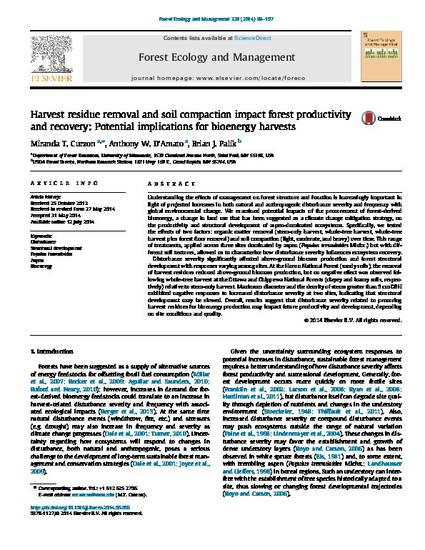
Article
Harvest residue removal and soil compaction impact forest productivity and recovery: Potential implications for bioenergy harvests
Forest Ecology and Management
(2014)
Abstract
Understanding the effects of management on forest structure and function is increasingly important in
light of projected increases in both natural and anthropogenic disturbance severity and frequency with
global environmental change. We examined potential impacts of the procurement of forest-derived
bioenergy, a change in land use that has been suggested as a climate change mitigation strategy, on
the productivity and structural development of aspen-dominated ecosystems. Specifically, we tested
the effects of two factors: organic matter removal (stem-only harvest, whole-tree harvest, whole-tree
harvest plus forest floor removal) and soil compaction (light, moderate, and heavy) over time. This range
of treatments, applied across three sites dominated by aspen (Populus tremuloides Michx.) but with different
soil textures, allowed us to characterize how disturbance severity influences ecosystem recovery.
Disturbance severity significantly affected above-ground biomass production and forest structural
development with responses varying among sites. At the Huron National Forest (sandy soils), the removal
of harvest residues reduced above-ground biomass production, but no negative effect was observed following
whole-tree harvest at the Ottawa and Chippewa National Forests (clayey and loamy soils, respectively)
relative to stem-only harvest. Maximum diameter and the density of stems greater than 5 cm DBH
exhibited negative responses to increased disturbance severity at two sites, indicating that structural
development may be slowed. Overall, results suggest that disturbance severity related to procuring
harvest residues for bioenergy production may impact future productivity and development, depending
on site conditions and quality.
Keywords
- Disturbance,
- Structural development,
- Populus tremuloides,
- Aspen,
- Bioenergy
Disciplines
Publication Date
2014
DOI
10.1016/j.foreco.2014.05.056
Publisher Statement
2014 Elsevier B.V. All rights reserved
Citation Information
Works produced by employees of the U.S. Government as part of their official duties are not copyrighted within the U.S. The content of this document is not copyrighted.
